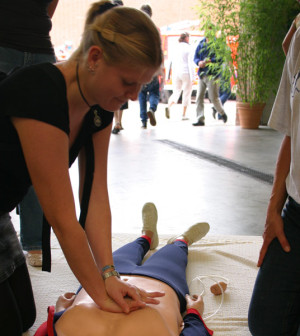- Skip Storing This Everyday Product in the Fridge Door
- Green Tea + B3 Pairing May Boost Brain Health
- Navigating Your Midlife Crisis: Embracing New Possibilities
- City Raccoons Showing Signs of Domestication
- Mapping the Exposome: Science Broadens Focus to Environmental Disease Triggers
- One Week Less on Social Media Linked to Better Mental Health
- Your Brain Changes in Stages as You Age, Study Finds
- Some Suicide Victims Show No Typical Warning Signs, Study Finds
- ByHeart Formula Faces Lawsuits After Babies Sickened With Botulism
- Switch to Vegan Diet Could Cut Your Greenhouse Gas Emissions in Half
Brain Scans Yield Clues to Future Stroke Risk


Brain scans taken shortly after a mild stroke can help identify patients at risk of suffering another stroke within three months, a new study suggests.
The study included more than 2,000 people who had CT scans of the brain within 24 hours of suffering a mild, non-disabling stroke or a transient ischemic attack, which are sometimes called “mini-strokes.” Of those patients, 40 percent had brain damage due to a lack of sufficient blood flow (ischemia).
Compared to people who didn’t have an interruption in blood flow to part of their brains, the risk of another stroke within 90 days was almost three times higher in those with new brain damage due to poor blood circulation (acute ischemia), according to the researchers.
The study also found that the risk of another stroke was more than five times higher in people with previous brain damage from ischemia (chronic ischemia) in addition to the damage from the recent stroke.
The risk was also nearly five times higher in people with damage from insufficient blood flow along with any type of small blood vessel damage in the brain, according to the study. An example of small blood vessel damage is the narrowing of the small vessels (microangiopathy) in the brain.
The study also found that the risk of another stroke was about eight times higher in those people who had recent damage from ischemia and chronic ischemia, as well as small blood vessel damage.
While slightly more than 3 percent of all the patients in the study had another stroke within 90 days, the rate was 25 percent among those with all three types of damage to the brain, the researchers found.
“During the 90-day period, and also within the first two days after the initial attack, patients did much worse in terms of experiencing a subsequent stroke if they had additional areas of damage along with acute ischemia,” co-senior author Dr. Jeffrey Perry, an associate professor of emergency medicine at the University of Ottawa in Canada, said in a news release from the American Heart Association.
“These findings should prompt physicians to be more aggressive in managing patients with transient ischemic attack [mini-stroke] or non-disabling stroke who are diagnosed with acute ischemia, especially if there is additional chronic ischemia and/or microangiopathy,” he added.
Measures to prevent another stroke include heart monitoring or medications that lower blood pressure and cholesterol, or drugs to prevent blood clots, the researchers suggested.
The study was published online Dec. 4 in the journal Stroke.
More information
The U.S. National Heart, Lung, and Blood Institute has more about stroke.
Source: HealthDay
Copyright © 2025 HealthDay. All rights reserved.










